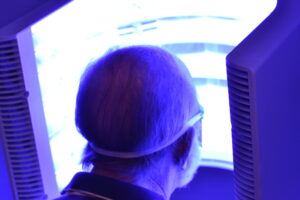 While Actinic Keratosis is not a household term for most people, it occurs fairly commonly in people over 40, and, if left untreated, can lead to skin cancer. Actinic Keratosis, which is usually found on the hands, forearms, ears, lips, and face, begins as a rough, scaly patch of skin in an area that has repeatedly received sun damage.
While Actinic Keratosis is not a household term for most people, it occurs fairly commonly in people over 40, and, if left untreated, can lead to skin cancer. Actinic Keratosis, which is usually found on the hands, forearms, ears, lips, and face, begins as a rough, scaly patch of skin in an area that has repeatedly received sun damage.
While there are a few ways to treat precancerous Actinic Keratosis before it becomes malignant, many of these treatments have lengthy recovery times and can cause discomfort if a large area of the skin is treated. Photodynamic Therapy, or PDT, on the other hand, is a well-tolerated option that has proven quite effective in destroying sun-damaged cells before they have a chance to become cancerous.
What is Photodynamic Therapy (PDT)? How Does it Work?
PDT utilizes a chemical called Aminolevulinic acid to destroy precancerous skin lesions. The chemical is placed on parts of the skin showing signs of Actinic Keratosis and then activated with ultraviolet light. The light produces a chemical reaction upon the surface of the skin, (called a cytotoxic effect), that destroys the sun-damaged cells and greatly minimizes the probability of cancer developing later on.
What Should You Expect During a PDT Treatment?
The outpatient procedure is simple, noninvasive, and will take between one and three hours. Patients have their skin cleaned before the Aminolevulinic acid is applied. After application, there is some waiting time, so the skin can fully absorb the solution. The skin is then exposed to light for about 15 minutes. You will be given eye protection for this phase of the treatment.
Does PDT Have Side Effects? What Happens After a Treatment?
Most patients respond excellently to PDT and their side effects are minimal. Some patients do report a slight burning sensation, particularly in the treated areas. They may also have some redness and peeling, which normally subsides in a few days. Others may experience extreme sensitivity to light, which lasts about 48 hours. During this time, patients should avoid direct sunlight, wear protective clothing when outdoors, and be advised that sunscreen has minimal benefit during this time.
How Effective is PDT in Treating Actinic Keratosis?
Photodynamic Therapy is highly effective in treating Actinic Keratosis. When used properly, it has no long term side effects, and it is less invasive, and often less expensive, than surgery or other preventative treatments. It also can be targeted very precisely to the affected areas and there is no scarring as the skin heals.
Contact Us
If you suspect that you may suffer from Actinic Keratosis or any other form of sun damage, and would like to discuss how to reduce your risk of skin cancer, contact us today. We would love to discuss if PDT might be a practical solution for you.
In the meantime, don’t forget the sunscreen!
